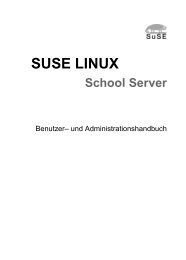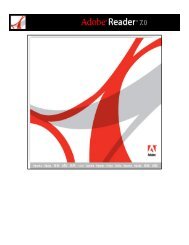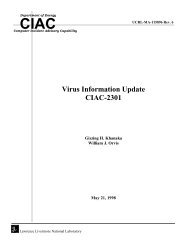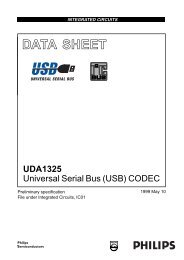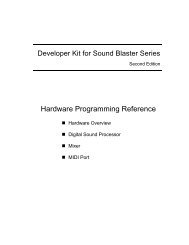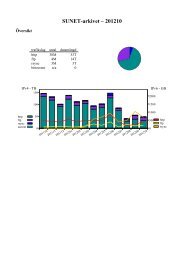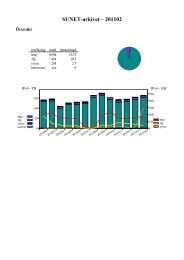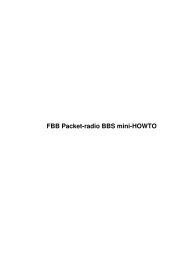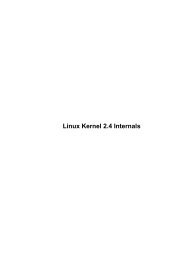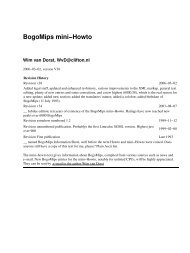Tamil Linux HOWTO - The Linux Documentation Project
Tamil Linux HOWTO - The Linux Documentation Project
Tamil Linux HOWTO - The Linux Documentation Project
Create successful ePaper yourself
Turn your PDF publications into a flip-book with our unique Google optimized e-Paper software.
<strong>Tamil</strong> <strong>Linux</strong> <strong>HOWTO</strong><br />
V. Venkataramanan<br />
<br />
D Sivaraj − Initial conversion from LaTeX to Docbook XML<br />
Copyright © 2002, 2003 V. Venkataramanan<br />
Jan 2003<br />
Revision History<br />
Revision 1.0 2003−02−14 Revised by: venkat<br />
Initial release, reviewed by LDP<br />
Revision 0.9 2003−1−21 Revised by: venkat<br />
Changes made to comply to TDLP specs.<br />
Revision 0.8 2002−10−24 Revised by: venkat<br />
First draft<br />
This document will help set up a working <strong>Tamil</strong> <strong>Linux</strong> environment. This describes setting up fonts, keyboard<br />
drivers, editing and printing <strong>Tamil</strong>/bilingual documents, and working with the X Window system. <strong>The</strong><br />
information is kept as generic as possible. When it pertains to a specific distribution (say RedHat or Debian),<br />
it is explicitly noted.
<strong>Tamil</strong> <strong>Linux</strong> <strong>HOWTO</strong><br />
Table of Contents<br />
1. About this <strong>HOWTO</strong>........................................................................................................................................1<br />
1.1. Purpose/Scope of this <strong>HOWTO</strong>........................................................................................................1<br />
1.2. Feedback...........................................................................................................................................1<br />
1.3. Copyright and License......................................................................................................................1<br />
1.4. Acknowledgements...........................................................................................................................1<br />
2. Introduction.....................................................................................................................................................2<br />
3. Fonts.................................................................................................................................................................3<br />
3.1. TSCII................................................................................................................................................3<br />
3.2. TAB..................................................................................................................................................3<br />
3.3. Miscellaneous fonts and encodings..................................................................................................4<br />
4. Console <strong>Tamil</strong>..................................................................................................................................................5<br />
5. X Window........................................................................................................................................................6<br />
5.1. Installing fonts..................................................................................................................................6<br />
5.2. Bitmapped fonts................................................................................................................................6<br />
5.3. TrueType fonts..................................................................................................................................7<br />
5.3.1. Installing TrueType Fonts.......................................................................................................7<br />
5.4. Other Font Servers............................................................................................................................9<br />
6. Keyboard Drivers..........................................................................................................................................10<br />
6.1. tamil_kmap.....................................................................................................................................10<br />
6.2. tamilvp............................................................................................................................................10<br />
7. KDE................................................................................................................................................................11<br />
7.1. Getting Localization Files...............................................................................................................11<br />
7.2. Choosing a <strong>Tamil</strong> locale.................................................................................................................11<br />
7.3. Choosing <strong>Tamil</strong> fonts for GUI........................................................................................................11<br />
7.4. KDE Miscellaneous........................................................................................................................12<br />
8. GNOME.........................................................................................................................................................13<br />
9. Printing..........................................................................................................................................................14<br />
9.1. LATEX...........................................................................................................................................14<br />
9.2. Postscript.........................................................................................................................................14<br />
9.3. PDF.................................................................................................................................................14<br />
10. Word Processors, Office Packages............................................................................................................15<br />
11. Viewing Web pages.....................................................................................................................................16<br />
12. Pango............................................................................................................................................................17<br />
13. Miscellaneous...............................................................................................................................................18<br />
i
<strong>Tamil</strong> <strong>Linux</strong> <strong>HOWTO</strong><br />
Table of Contents<br />
A. Appendix of <strong>Tamil</strong> Font Encodings............................................................................................................19<br />
ii
1. About this <strong>HOWTO</strong><br />
1.1. Purpose/Scope of this <strong>HOWTO</strong><br />
This document will help set up a working <strong>Tamil</strong> <strong>Linux</strong> environment. Step−by−step instructions are provided<br />
for setting up fonts, editors, etc. This document also describes the essential instructions need to use web<br />
browsers, edit documents and print them.<br />
<strong>The</strong> base URL of this document is:<br />
1.2. Feedback<br />
Comments and suggestions about this document may be directed to the author<br />
()<br />
1.3. Copyright and License<br />
© 2002, 2003 V.Venkataramanan.<br />
Permission is granted to copy, distribute and/or modify this document under the terms of the GNU Free<br />
<strong>Documentation</strong> License, Version 1.2 or any later version published by the Free Software Foundation; with no<br />
invariant Front−Cover text, no Back−Cover text and no invarient sections.<br />
A verbatim copy of the license can be obtained from the Free Software Foundation Website at<br />
http://www.gnu.org/licenses/fdl.html<br />
1.4. Acknowledgements<br />
Several postings by the following people were useful in writing this document. <strong>The</strong> following people are<br />
thanked for all their help:<br />
Thuraiappah Vaseeharan, D. Sivaraj, Sivakumar Shanmugasundaram, Dinesh Nadarajah, Anbumani<br />
Subramanian, Ganesan Rajagopal, M.K. Saravanan,...<br />
1. About this <strong>HOWTO</strong> 1
2. Introduction<br />
<strong>Tamil</strong> is a member of the Dravidian languages. Its origin is in southern India and the language is written with<br />
non−Roman alphabets. So there is a need for special fonts, encoding, keyboard layout and drivers, besides<br />
localization, including currency, date format, etc. This document will give a complete overview of setting up<br />
and working in the <strong>Tamil</strong> <strong>Linux</strong> environment. <strong>The</strong>re are several pieces of information and tools available for<br />
<strong>Linux</strong> in <strong>Tamil</strong>; this how−to will serve as a meta−index to all the scattered resources.<br />
A word before you enter − most of the fonts, tools, RPMs and documents are being gathered under one site.<br />
So try the resources at http://tamil.homelinux.org before you embark on treasure−hunting.<br />
2. Introduction 2
3. Fonts<br />
It can seem like anarchy. <strong>The</strong>re are an unknown number of fonts, each encoded with their own tables, driven<br />
by arbitrary keyboard layouts and outputs. In my opinion, <strong>Tamil</strong> can seriously compete with any other<br />
language for maximum number of font tables. Added to this commotion are the dynamic fonts for the web<br />
pages, that enable anyone to get away with a non−standard font as long as his pages are viewable.<br />
Adding to all these is the official Indian Standard Code for Information Interchange (ISCII), the Government<br />
of India sponsored "unifying" scheme to bring all Indian fonts under the Devanagari umbrella. Anyone<br />
familiar with the way the characters are written in <strong>Tamil</strong> and in Devanagari script will understand the lack of<br />
any rationale in this approach.<br />
Needless to say, this is serving to only add to the confusion. A good analysis of this and the unicode for <strong>Tamil</strong><br />
is once again written by Sivaraj and can be found at . For those not familiar with the <strong>Tamil</strong> script, a good<br />
introduction written by Sivaraj is at .<br />
Let us ignore the anarchy for a moment and get a picture of the frequently used font encodings. <strong>The</strong>re are two<br />
main contenders and luckily they will converge soon. <strong>The</strong> first and most popular one is the <strong>Tamil</strong> Standard<br />
Code for Information Interchange (TSCII), developed by volunteers throughout the world, and the other,<br />
TAmil Monolingual (TAM), and TAmil Bilingual (TAB) encodings, were proposed by the <strong>Tamil</strong> Nadu<br />
Government. Once again, TAM is of limited use in an OS environment and we can safely ignore that. Almost<br />
all <strong>Linux</strong> efforts are in TSCII (Console, KDE, GNOME localizations).<br />
3.1. TSCII<br />
TSCII is a glyph−based, 8−bit bilingual encoding. It uses a unique set of glyphs; the usual lower ASCII set.<br />
Roman letters with standard punctuation marks occupy the first 128 slots and the <strong>Tamil</strong> glyphs occupy the<br />
upper ASCII segment (slots 128−256). A good overview of the early font encoding schemes and a the<br />
rationale behind the TSCII approach can be found at http://www.geocities.com/Athens/5180/tscii.html.<br />
<strong>The</strong> home URL for TSCII volunteers is http://www.tamil.net/tscii. This site discusses the TSCII encoding and<br />
provides tools including fonts, keyboard drivers, editors and inter−conversion tools for various platforms. <strong>The</strong><br />
font encoding table according to TSCII−1.6 can be found at http://www.tamil.net/tscii/charset16.gif.<br />
<strong>The</strong> current version of TSCII is 1.6, and a revision is expected anytime now that will fix some anomalies in<br />
using various slots for encoding. This version 1.7 will be fully backward compatible with 1.6 and is expected<br />
to gain popularity. <strong>The</strong> TSCII discussion group currently brainstorms on modifications to TSCII−1.6. You<br />
may be able to participate in the discussions by becoming a member. You may also be able to download<br />
various beta tools from there. <strong>The</strong> font encoding table according to TSCII−1.7 (draft) can be found at .<br />
3.2. TAB<br />
TAB is a character based bilingual standard proposed by the government of <strong>Tamil</strong> Nadu. <strong>The</strong> TAB bilingual<br />
encoding table can be found at http://www.tamilnet99.org/annex4.htm. Tools for TAB encoding (mostly<br />
restricted to the Windows platform) can also be downloaded in the vicinity of this page.<br />
3. Fonts 3
<strong>Tamil</strong> <strong>Linux</strong> <strong>HOWTO</strong><br />
3.3. Miscellaneous fonts and encodings<br />
<strong>The</strong>re are too many types, and unfortunately they are not documented well. It is beyond the scope of this<br />
document to discuss them.<br />
3. Fonts 4
4. Console <strong>Tamil</strong><br />
This so far has been a one man effort − once again by Sivaraj. He has written a set of console tools for <strong>Tamil</strong><br />
that include a monospace font, keyboard driver and locale setup. In his words:<br />
You can use it with Lynx to read any TSCII−based web sites or Pico to email in TSCII.<br />
Some characters may be disoriented, since I try to fit all the characters in an 8x16 cell.<br />
But it is still readable.<br />
−−Sivaraj<br />
<strong>The</strong> tools can be downloaded here. Follow the instructions in the REAME file to install and use.<br />
4. Console <strong>Tamil</strong> 5
5. X Window<br />
Welcome! This is where you will find the most useful tools for <strong>Tamil</strong>. Even for basic users, it is now possible<br />
to have close to a total <strong>Tamil</strong>−localized office suite. <strong>Tamil</strong> GUI is achieved in KDE or GNOME environment<br />
with localization settings (more about this later in this document), and <strong>Tamil</strong> character input is achieved using<br />
keymanager programs. But first you need to get some fonts to do all this.<br />
5.1. Installing fonts<br />
<strong>Linux</strong>, by default, uses "pcf" fonts and one can also use "bsd" fonts; these are bitmapped fonts that display<br />
under X and can be printed. But, as is common with all bitmapped fonts, these are not always WYSIWYG in<br />
print. For high−quality printing you need "Type−I" fonts (Adobe), with Ghostscript you need PS fonts and for<br />
"afm" fonts (American Font metrics) are used. But most of the <strong>Tamil</strong> fonts that are freely available are<br />
TrueType (ttf). We will see next how to get all these fonts working.<br />
5.2. Bitmapped fonts<br />
A bitmapped font is a matrix of dots; because of this, these fonts are device−independent. A 75 dpi font,<br />
which is good enough for displaying, is still a 75 dpi font in your 1200 dpi printer. So usually bitmapped fonts<br />
are created for a specific purpose, such as for displaying on a monitor or for printing. <strong>Linux</strong> usually uses bdf<br />
or pcf font for console or X display. Fonts like those created by dvips or dvi are printer−related bitmapped<br />
fonts. <strong>The</strong>se fonts occupy large sizes, but programs circumvent this by dynamically creating them as and<br />
when they are needed, and at a specific resolution.<br />
You can get bitmapped <strong>Tamil</strong> fonts for various applications from:<br />
When an application makes a font request to the X Server, XFree86 looks for fonts in specific directories.<br />
This means that when you add fonts to your system and you want them to be recognized by X Server, you<br />
need to tell X about the location of these fonts. Simply add a directory to your font path with the commands:<br />
mkfontdir<br />
xset fp+ <br />
where the family directory is the name of the directory where you have fonts. Once you have done this you<br />
have to ask the server to get this registered for the session, with the command<br />
xset fp rehash<br />
Since you will want these commands to run automatically, you should put them in your .xinitrc file ( or<br />
possibly your .Xclients or .xsession file −− this depends on how you start X. Another way to have the<br />
commands set automatically is edit XF86Config. For example, to add /usr/share/fonts/myfonts to the font<br />
path when X is started, edit XF86Config like this:<br />
...<br />
Section "Files"<br />
...<br />
FontPath /usr/share/fonts/myfonts<br />
...<br />
EndSection<br />
5. X Window 6
...<br />
<strong>The</strong> advantage of editing XF86Config is that the resulting changes are system wide.<br />
5.3. TrueType fonts<br />
You may get TrueType fonts for TSCII, TAB and TSCII1.7 encoding from the download section of<br />
http://tamil.homelinux.org/. Alternate sources for these fonts are<br />
TSCII − http://www.tamil.net/tscii/<br />
TAB − http://www.tamilnet99.org/ and http://www.thinnai.com<br />
TSCII−1.7 (experimental) − http://groups.yahoo.com/group/tscii/files/<br />
Installing these fonts are either too easy or too difficult. Too easy if you have one of the latest distributions,<br />
like RedHat7.x or Mandrake7.x. This is because RedHat (and Mandrake, maybe SuSE) come with xfs<br />
pre−packaged. It is also easy to find xfs for Debian, but as far as I know, Debian does not come with xfs<br />
packaged.<br />
Debian users are now redirected to this mini−howto on TrueType fonts in Debian −<br />
http://www.linuxdoc.org/<strong>HOWTO</strong>/mini/TT−Debian−3.html<br />
<strong>The</strong>re is also another utility, xfstt, which is easier to install and use, but xfs is becoming popular as it can<br />
handle Adobe Type1 in addition to TrueType fonts.<br />
If you do not have either of these, consider getting either xfs (not to be confused with Silicon Graphics (SGI)<br />
sponsored XFS journaling file system) from http://www.xfree86.org.<br />
or xfstt from http://www.dcs.ed.ac.uk/home/jec/programs/xfsft/. You may also get xfstt binaries from<br />
http://independence.seul.org/, or reading an article about xfstt in the <strong>Linux</strong> Gazette at<br />
5.3.1. Installing TrueType Fonts<br />
You need to run these commands as root. If you are currently logged in as a normal user, you can use su to do<br />
this now.<br />
You should now have xfs availability, otherwise use the steps in the previous section to obtain it.<br />
In some distributions like Mandrake, installing TrueType fonts is a cakewalk. Just go to DrakConf and use the<br />
font install utility − follow a few easy steps there and you'll have them all.<br />
Put your TrueType fonts in whatever directory you want. For example, /usr/share/tamiltt.<br />
From within the directory containing your new fonts, type:<br />
ttmkfdir −m 50 −o fonts.scale<br />
<strong>Tamil</strong> <strong>Linux</strong> <strong>HOWTO</strong><br />
This makes a file that will contain the necessary information about the fonts for the xfs server. <strong>The</strong> option −m<br />
50 specifies the magnification for the fonts; I have seen some <strong>Tamil</strong> fonts working well only with −m 100.<br />
5. X Window 7
<strong>The</strong>n type:<br />
mkfontdir<br />
Now you can add the new directory to your xfs search path. Red Hat (and Red Hat−like) distributions come<br />
with a neat utility to do this called chkfontpath. Run chkfontpath like this:<br />
chkfontpath −−add /usr/share/tamiltt<br />
This will add the new font directory to your font path.<br />
(Other users, who have an xfs font server, without ttf support, can do this by editing their xfs configuration<br />
file.<br />
If xfs is already installed on your system, you should see which port it is running on. You can do this with the<br />
following command:<br />
ps ax grep xfs<br />
<strong>The</strong>n check your XFree86 font path with this command:<br />
xset −q<br />
If your font path includes something like "unix:/port number," where port number is the port on which the<br />
server is running, then you already have xfs set up properly. Otherwise, you should add it to your XFree86<br />
font path with these commands:<br />
xset fp+ <br />
xset fp rehash<br />
<strong>The</strong> port number is a numerical value, something like 7100.<br />
You can add the fontpath permanently by editing your .xinitrc. To add it system−wide, edit your<br />
XF86Config file (either under /etc/X11/XF86Config, /etc/X11/XF86Config−4,<br />
/etc/XF86Config, or /usr/X11R6/lib/X11/XF86Config), by adding the following line to the<br />
Files section:<br />
FontPath "unix/:port number"<br />
Here is an example of how it should look:<br />
...<br />
Section Files<br />
...<br />
FontPath "unix/:−1"<br />
...<br />
EndSection<br />
...<br />
<strong>Tamil</strong> <strong>Linux</strong> <strong>HOWTO</strong><br />
5. X Window 8
If xfs is already properly installed, then you can restart it like this as root:<br />
service xfs restart<br />
After restarting xfs, it is a good idea to restart your X session.<br />
As most of the users in <strong>Tamil</strong> will be doing this, let me summarize the essential steps.<br />
1. Become root.<br />
2. Download and copy some ttf fonts into a directory (say /usr/share/fonts/tamiltt ).<br />
3. Go to that directory and do a ttmkfdir −m 50 −o fonts.scale (use the −m 100 option if your fonts do<br />
not budge).<br />
4. Do a mkfontdir . (Notice that you need to specify the directory either absolutely or with a dot).<br />
5. Do a chkfontpath −−add /usr/share/fonts/tamiltt . (Remember this command is available only in<br />
Red Hat−like distributions. If you can run this successfully, skip the remaining steps and restart the X<br />
server).<br />
6. Do ps ax | grep xfs and get the xfs port known.<br />
7. Check your font path: xset −q<br />
If your font path includes something like "unix:/port number", (something like "unix: 7100"), add this<br />
to your xfont path:<br />
xset fp+ unix: port number<br />
xset fp rehash<br />
8. It is a good idea to restart the X Server.<br />
9. If everything works fine, update your .xinitrc file, wherever it is.<br />
10. Have fun!<br />
5.4. Other Font Servers<br />
<strong>Tamil</strong> <strong>Linux</strong> <strong>HOWTO</strong><br />
<strong>The</strong>re is another project, X−TrueType Server, worth looking into, at http://www.io.com/~kazushi/xtt/.<br />
Another interesting project with broader scope is FreeType; check http://www.freetype.org.<br />
I personally feel xfs is a great utility; it can handle Type1 fonts (very useful if you use programs like GIMP).<br />
Besides, a stand alone xfs server is not attached to X server. This means that you can deliver these fonts for<br />
remote X displays. I use this feature extensively with VNC Server running in my host and VNC Viewer<br />
running locally in Windows. It's something of a luxury having a <strong>Tamil</strong> <strong>Linux</strong> desktop while working for my<br />
employer.<br />
5. X Window 9
6. Keyboard Drivers<br />
Once again, lack of standards shows up here. <strong>The</strong>re are quite a few <strong>Tamil</strong> keyboard layouts, the traditional<br />
typewriter keyboard; then with the surge of internet arrived the romanized transliteration keyboards; later the<br />
TAmil−Nadu government played its part by prescribing a tamilnet99 keyboard. <strong>The</strong>se are only a few to talk<br />
about; we have a few others which do not fall into any of these "standards."<br />
<strong>The</strong>re are two <strong>Tamil</strong> keyboard drivers for the X Window System, both of them set to tamilnet99 standards<br />
(see tamilnet99 website for the details on the keymap). You will be able to download both the keydrivers from<br />
the Yahoo! tamilinix group files section .<br />
6.1. tamil_kmap<br />
<strong>The</strong> first driver is tamil_kmap, created by Vasee. It is based on the original version of Siva. It is operable<br />
under both TSCII 1.6 and TAB encodings. <strong>The</strong> detailed installation instructions are given in the README file<br />
in the package. It is very simple to install. First, untar the package into a temporary directory. <strong>The</strong>n type:<br />
cp ta /usr/X11R6/lib/X11/xkb/symbols/<br />
then: cp Compose /usr/X11R6/lib/X11/locale/iso8859−1<br />
and put the shell script setkb into a directory on your system PATH . You may need to become root to copy<br />
these files into these directories.<br />
To use the <strong>Tamil</strong> keyboard, type setkb tscii or setkb tab. From inside the keyboard driver you will be able to<br />
switch between the two standards, and also between Roman and <strong>Tamil</strong> fonts.<br />
6.2. tamilvp<br />
<strong>The</strong> other keyboard driver, tamilvp (vp for Visaip Palakai) is written and maintained by Dinesh. As indicated<br />
above, you may download that from the Yahoo! tamilinix group file section. It is available as rpm (I have not<br />
tried it out yet). Just install the rpm and files will be in appropriate locations. To run the program type tamilvp<br />
and you will get the GUI cell to choose between <strong>Tamil</strong> (TSCII 1.6 or TAB) and English.<br />
6. Keyboard Drivers 10
7. KDE<br />
Historically, the K Desktop Environment (KDE) was the first full <strong>Tamil</strong> user interface. Though far from<br />
complete, KDE was there for <strong>Tamil</strong>, and <strong>Tamil</strong> among the Indic languages, for the first time. Under KDE,<br />
with your localization properly set to <strong>Tamil</strong>, you may be able to do almost everything (from editing files, to<br />
browsing the web and e−mail, to administrative tasks such as user management and task scheduling) with a<br />
<strong>Tamil</strong> user interface.<br />
7.1. Getting Localization Files<br />
For the newbie, it is very easy to search the web for <strong>Tamil</strong> KDE localizations RPMs. <strong>The</strong>y are usually labelled<br />
something like kde−i18n−<strong>Tamil</strong>−2.0−1mdk.i586.rpm. i18n is just that: i(nternationalizatio)n,<br />
18(18letters). <strong>Tamil</strong> is the localization setting corresponding to the <strong>Tamil</strong> language. mdk signifies the<br />
package for Mandrake distribution. <strong>The</strong>n comes the most important part; 2.0−1, the KDE version number.<br />
Your base KDE version and this should be the same, so when downloading, make sure that you get the proper<br />
localized menus for the proper KDE version. i586 signifies the precompiled binaries for the intel 586<br />
platforms. Make sure that you get the proper binary (there are usually source rpms and rpms for other<br />
platforms such as alpha). If you are a newbie you are better off using GUI based rpm installer such as<br />
GNORPM or KPackage. First do a test install and check if your system has all the needed packages. If not go<br />
to the same source from where you downloaded the <strong>Tamil</strong> localization and get them. After making sure that<br />
you installed all dependencies, install the kde−i18n−tamil package as well.<br />
If you are not a newbie, you know it. Get KDE <strong>Tamil</strong> i18n files, and if you have time, get the sources and<br />
compile them!<br />
KDE localization uses TSCII 1.6 encoding. This means that you will need at least one TSCII font. Read the<br />
section on fonts as to how to get it.<br />
7.2. Choosing a <strong>Tamil</strong> locale<br />
This section assumes that have installed at least one TSCII font (preferably several, to jazz up your GUI) and<br />
the KDE <strong>Tamil</strong> localization package.<br />
From Start, go to configuration > KDE > Personalization and choose default (c) location.<br />
<strong>Tamil</strong>/India is yet to be made available under countries/languages.<br />
Choose language >other ><strong>Tamil</strong>. Accept this. All changes will be activated, and will work on all windows<br />
opened subsequently.<br />
Your user interface is now set in <strong>Tamil</strong>. If you see some garbage on the window header etc., pat yourself on<br />
the back. You are ready to see <strong>Tamil</strong>; move on!<br />
7.3. Choosing <strong>Tamil</strong> fonts for GUI<br />
Again, from Start go to configuration >KDE >LooknFeel. You will see a set of fonts for most (these are the<br />
ones used in display). Choose a <strong>Tamil</strong> font instead for all these. Accept.<br />
7. KDE 11
Well done, you now see <strong>Tamil</strong> everywhere on your desktop. You are ready, with a fully operational <strong>Tamil</strong><br />
system.<br />
7.4. KDE Miscellaneous<br />
<strong>Tamil</strong> <strong>Linux</strong> <strong>HOWTO</strong><br />
As with every other project, KDE−<strong>Tamil</strong> also needs a lot of volunteers. Contact either Sivakumar or<br />
Vaseeharan (both of them can be reached through the egroup<br />
Visit before you try KDE <strong>Tamil</strong>. If you want to convince yourself (and be bowled over), view the screenshots<br />
from tamillinux.org site.<br />
KDE's i18n process is unicode−based. As a work around, Trolltech's QTsciiCodec class provides conversion<br />
to and from the <strong>Tamil</strong> TSCII encoding. This codec uses the mapping table found at . Unfortunately <strong>Tamil</strong> uses<br />
composed Unicode. As such, Unicode fonts cannot be used under KDE−TSCII; you need to have TSCII fonts.<br />
<strong>The</strong> TSCII codec was contributed to Qt by Hans Petter Bieker .<br />
7. KDE 12
8. GNOME<br />
GNOME <strong>Tamil</strong> localization works have just begun. <strong>The</strong>re are few applications for which <strong>Tamil</strong> menus are<br />
translated, and are available. But it is yet to become the official member of GNOME i18n distribution.<br />
In order to use them, download the currently available files from:<br />
http://www.tamillinux.org/gnome/gnome.html<br />
and put them into the directory /usr/share/locale/ta/LCMESSAGES/.<br />
Under GNOME Control Panel you have set the fonts (both in <strong>The</strong>mes and the Window Manger applet) to a<br />
TSCII font.<br />
You need to create binary messages from the po files. This is done as follows:<br />
msgfmt xxx.po −o /usr/share/locale/ta/LCMESSAGES/xxx.mo.<br />
Note that the binary messages files contain an extension .mo as opposed to .po for the text file.<br />
In order for you see <strong>Tamil</strong>, you have to set the locale to <strong>Tamil</strong>.<br />
If you are using bash as your shell, then enter the following line in your home directory.<br />
export LANG=ta<br />
export LANGUAGE=ta<br />
export LC ALL=ta<br />
Restart the X server. You should see <strong>Tamil</strong> menus and dialogs in many of the GNOME enabled applications.<br />
Once again, please consider contributing to the <strong>Tamil</strong> GNOME <strong>Project</strong>; we need a lot of volunteers. Contact<br />
Dinesh or through tamilinix yahoogroups.<br />
8. GNOME 13
9. Printing<br />
This section is all about getting high−quality <strong>Tamil</strong> output in printing. While it is one issue to load a binary<br />
font and start using <strong>Tamil</strong> in <strong>Linux</strong>, if your work is to destroy the forests, you need high−quality printing too!<br />
9.1. L A T EX<br />
L A TEX is perhaps the mother of all typographic systems. It frees the author from the trivia of typesetting and<br />
concentrate on the content. It does not use the WYSWYG input, but the end result is great. Recent<br />
developments are centered toward internationalization. Unfortunately lack of unicode standard does not<br />
permit <strong>Tamil</strong> to be tried under the more ambitious Omega <strong>Project</strong>. Once again, workaround is the only way. A<br />
first step in <strong>Tamil</strong> has been attempted by Thuraiappah Vaseeharan. You may get the the package from the<br />
tamillinux.org site. <strong>The</strong> tar ball contains a great readme file that describes the installation and usage. <strong>The</strong><br />
tamiltex package does a short work by keeping all related stuff under one directory (which means that you<br />
need to keep your work under the same directory to compile your source files). But the great thing about this<br />
package is that it is compatible with both TSCII and TAB encodings and the results are just what you would<br />
expect from a L A TEX package − great!<br />
9.2. Postscript<br />
Many <strong>Linux</strong> applications use Ghostscript to print, which means that you must have Ghostscript configured if<br />
you want to use <strong>Tamil</strong> in printed documents. If L A TEX is there, can PostScript be far away? Not thanks to<br />
Vasee. Set the environment variable GS_FONTPATH to point to your TrueType font directory. For example, I<br />
have:<br />
GS_FONTPATH=/usr/local/share/fonts/tamiltt<br />
export GS FONTPATH<br />
You should be able to view <strong>Tamil</strong> PostScript files.<br />
9.3. PDF<br />
As of now, the only source to create PDF files is the PDF package. If you are able to successfully compile<br />
your source with the tamiltex package, use<br />
pdflatex source.tex<br />
to generate the PDF file. You should be able to view it, using xdvi or Adobe's Acroread for <strong>Linux</strong>.<br />
9. Printing 14
10. Word Processors, Office Packages<br />
Once TrueType fonts are installed properly, there is no problem using them in Abiword, GNumeric or<br />
KOffice. However, StarOffice needs Type 1 fonts. (I hear the latest StarOffice supports TrueType fonts?).<br />
You can expect Type 1 <strong>Tamil</strong> fonts to be available shortly:−).<br />
For receiving and sending email, KMail works well with TrueType fonts. You should also be able to use<br />
PINE with Sivaraj's console fonts and utils.<br />
10. Word Processors, Office Packages 15
11. Viewing Web pages<br />
Konquerer supports <strong>Tamil</strong> fonts neatly, once made at the proper scale under your font directory and served to<br />
X. Widely used Netscape, however, is a problem. Netscape uses only 75 dpi fonts for display. You might have<br />
noticed this even while viewing Roman fonts, and got annoyed seeing small fonts. That being the case with<br />
Roman, <strong>Tamil</strong> is impossible to comprehend under 75 dpi. This can, however, be fixed by specifying the<br />
appropriate resources in your .Xdefaults file:<br />
Netscape*documentFonts.sizeIncrement: 20<br />
Netscape*documentFonts.xResolution*iso−8859−1: 150<br />
Netscape*documentFonts.yResolution.iso−8859−1: 150<br />
Remember that TSCII fonts are used as ISO−8859−1 fonts. <strong>The</strong> parameter 150 is arbitrary; I have seen some<br />
fonts scaling neatly under 100 itself (TSCparanar, for one) which is good enough for viewing. If you are still<br />
not satisfied with what you see, try using anti−aliasing under X.<br />
11. Viewing Web pages 16
12. Pango<br />
Pango provides an open−source framework for the layout and rendering of internationalized text and uses<br />
Unicode for all of its encoding. It aims to eventually support output in all the major languages. When<br />
GNOME 2.0 comes out, the text rendering is expected to be by Pango. Pango is expected to be the panacea<br />
for complex font schemes like kanji, arabic/hebrew (bidirectional), so <strong>Tamil</strong> is no problem. <strong>Tamil</strong> is one of<br />
the early languages in Pango − right there in the first public version. Sivaraj provided TSCII support, which<br />
was later extended to TAB by Vikram.<br />
12. Pango 17
13. Miscellaneous<br />
For the latest news, views and tools in <strong>Tamil</strong> <strong>Linux</strong>:<br />
http://tamil.homelinux.org/<br />
Issues related to <strong>Tamil</strong> localization are mostly discussed at:<br />
http://groups.yahoo.com/group/tamilinix/<br />
Under the files section there you may get some tools, few <strong>HOWTO</strong>s (most of those issues are unified in this<br />
document already) and some tutorials.<br />
If you want to read about Open Source (Free Software) history in <strong>Tamil</strong>, see:<br />
http://www.tamillinux.org/venkat/cover.html<br />
Ganesan Rajagopal is checking in CVS for <strong>Tamil</strong> locales under the Sourceforge project on <strong>Tamil</strong> <strong>Linux</strong>, you<br />
may be get them from:<br />
http://cvs.sourceforge.net/cgi−bin/viewcvs.cgi/tamillinux/locale−ta/<br />
<strong>The</strong>re is a simple guide to setting up a working <strong>Tamil</strong> <strong>Linux</strong> environment, addressed to newbies, available at:<br />
http://www.tamillinux.org/venkat/tamil_inst.html<br />
13. Miscellaneous 18
A. Appendix of <strong>Tamil</strong> Font Encodings<br />
<strong>The</strong>re are several non−standard font encoding schemes for <strong>Tamil</strong>. <strong>The</strong>n there are a whole lot of fonts (used<br />
mostly by publishing houses in <strong>Tamil</strong> Nadu, such as Vikatan, Kumutham, thinamaNi, etc.) which do not<br />
comply with any of these. <strong>The</strong> three major font encoding schemes are;<br />
TSCII (<strong>Tamil</strong> Standard Code of Information Interchange − currently running in beta version 1.7); the first<br />
efforts by volunteers throughout world.<br />
TAB (TAmil Bilingual); proposed and approved by the <strong>Tamil</strong> Nadu government<br />
TSCII 1.6 Encoding Table<br />
vowels: a, aa/A, i, ii/I, u, uu/U, e, ee/E, ai, o, oo/O, au, aq<br />
consonants: k, ng, c, ny, t, N, th, n^, p, m, y, r, l, v, zh, L, R, n<br />
−−−−−−−−−−−−−−−−−−−−−−−−−−−−−−−−−−−−−−−−−−−−−−−−−−−−−−−−−<br />
Position | character name | TSCII glyph<br />
−−−−−−−−−|−−−−−−−−−−−−−−−−−−−−−−−−|−−−−−−−−−−−−−−−−−−−−−−<br />
Characters 0−127 are as in the standard lower ASCII set<br />
−−−−−−−−−|−−−−−−−−−−−−−−−−−−−−−−−−|−−−−−−−−−−−−−−−−−−−−−−<br />
128 80 | c128 | tamil numeral 0<br />
129 81 | c129 | tamil numeral 1<br />
130 82 | baseline single quote | tamil numeral 2<br />
131 83 | florin | tamil numeral 3<br />
132 84 | baseline double quote | tamil numeral 4<br />
133 85 | ellipsis | tamil numeral 5<br />
134 86 | dagger (single) | tamil numeral 6<br />
135 87 | dagger (double) | tamil numeral 7<br />
136 88 | circumflex | tamil numeral 8<br />
137 89 | per mil (thousand) | tamil numeral 9<br />
138 8A | S caron | modifier for aa/A<br />
139 8B | left single guillemet | modifier for I<br />
140 8C | OE ligature | modifier for Ii/I<br />
141 8D | c141 | modifier for u<br />
142 8E | c142 | modifier for uu/U<br />
143 8F | c143 | modifier for e<br />
144 90 | c144 | modifier for ee/E<br />
145 91 | open single quote | (left single guillemet)<br />
146 92 | close single quote | (right single guillemet )<br />
147 93 | open double quote | (left double guillemet)<br />
148 94 | close double quote | (right double guillemet )<br />
149 95 | bullet (large) | tamil numeral 10<br />
150 96 | en dash | tamil numeral 100<br />
151 97 | em dash | tamil numeral 1000<br />
152 98 | tilde | modifier for ai<br />
153 99 | unregistered trademark | tamil vowel a<br />
154 9A | s caron | tamil vowel aa/A<br />
155 9B | right single guillemet | tamil vowel i<br />
156 9C | oe ligature | tamil vowel ii/Ai<br />
157 9D | c157 | tamil vowel u<br />
158 9E | c158 | tamil vowel uu/U<br />
159 9F | Y diaeresis | tamil vowel e<br />
160 A0 | non−breaking space | (vacant)<br />
161 A1 | Spanish inverted ! | tamil vowel ee/E<br />
162 A2 | cents | tamil vowel ai<br />
163 A3 | pounds | tamil vowel o<br />
164 A4 | intl. monetary symbol | tamil vowel oo/O<br />
A. Appendix of <strong>Tamil</strong> Font Encodings 19
<strong>Tamil</strong> <strong>Linux</strong> <strong>HOWTO</strong><br />
165 A5 | yen | tamil vowel au<br />
166 A6 | broken bar | tamil vowel aq<br />
167 A7 | section symbol | tamil uyirmei ka<br />
168 A8 | diaeresis | tamil uyirmei nga<br />
169 A9 | copyright | copyright<br />
170 AA | feminine ordinal | tamil uyirmei ca<br />
171 AB | left double guillemet | tamil uyirmei nya<br />
172 AC | logicalnot | tamil uyirmei ta<br />
173 AD | soft hyphen (minus) | tamil uyirmei Na<br />
174 AE | registered trademark | registered trademark<br />
175 AF | macron | tamil uyirmei tha<br />
176 B0 | ring (also degrees) | tamil uyirmei n^a<br />
177 B1 | plus/minus | tamil uyirmei pa<br />
178 B2 | superscript 2 | tamil uyirmei ma<br />
179 B3 | superscript 3 | tamil uyirmei ya<br />
180 B4 | acute | tamil uyirmei ra<br />
181 B5 | micro symbol (or mu) | tamil uyirmei la<br />
182 B6 | pilcrow (paragraph) | tamil uyirmei va<br />
183 B7 | bullet (small) | bullet (small)<br />
184 B8 | cedilla | tamil uyirmei zha<br />
185 B9 | superscript 1 | tamil uyirmei La<br />
186 BA | masculine ordinal | tamil uyirmei Ra<br />
187 BB | right double guillemet | tamil uyirmei na<br />
188 BC | one−fourth | grantha letter ja<br />
189 BD | one−half | grantha letter sha<br />
190 BE | three−fourths | grantha letter sa<br />
191 BF | Spanish inverted ? | grantha letter ha<br />
192 C0 | A grave | grantha letter ksha<br />
193 C1 | A acute| | grantha letter sri<br />
194 C2 | A circumflex | tamil uyirmei ti/di<br />
195 C3 | A tilde | tamil uyirmei tii/dii<br />
196 C4 | A diaeresis | tamil uyirmei ku<br />
197 C5 | A ring | tamil uyirmei ngu<br />
198 C6 | AE ligature | tamil uyirmei cu<br />
199 C7 | C cedilla | tamil uyirmei nyu<br />
200 C8 | E grave | tamil uyirmei tu<br />
201 C9 | E acute | tamil uyirmei Nu<br />
202 CA | E circumflex | tamil uyirmei thu<br />
203 CB | E diaeresis | tamil uyirmei n^u<br />
204 CC | I grave | tamil uyirmei pu<br />
205 CD | I acute | tamil uyirmei mu<br />
206 CE | I circumflex | tamil uyirmei yu<br />
207 CF | I diaeresis | tamil uyirmei ru<br />
208 D0 | Icelandic Eth | tamil uyirmei lu<br />
209 D1 | N tilde | tamil uyirmei vu<br />
210 D2 | O grave | tamil uyirmei zhu<br />
211 D3 | O acute | tamil uyirmei Lu<br />
212 D4 | O circumflex | tamil uyirmei Ru<br />
213 D5 | O tilde | tamil uyirmei nu<br />
214 D6 | O diaeresis | tamil uyirmei kU<br />
215 D7 | multiply symbol | tamil uyirmei ngU<br />
216 D8 | O with oblique stroke | tamil uyirmei cU<br />
217 D9 | U grave | tamil uyirmei nyU<br />
218 DA | U acute | tamil uyirmei tU<br />
219 DB | U circumflex | tamil uyirmei NU<br />
220 DC | U diaeresis | tamil uyirmei thU<br />
221 DD | Y acute | tamil uyirmei n^U<br />
222 DE | Icelandic Thorn | tamil uyirmei pU<br />
223 DF | German sharp s | tamil uyirmei mU<br />
224 E0 | a grave | tamil uyirmei yU<br />
225 E1 | a acute | tamil uyirmei rU<br />
226 E2 | a circumflex | tamil uyirmei lU<br />
A. Appendix of <strong>Tamil</strong> Font Encodings 20
<strong>Tamil</strong> <strong>Linux</strong> <strong>HOWTO</strong><br />
227 E3 | a tilde | tamil uyirmei vU<br />
228 E4 | a diaeresis | tamil uyirmei zhU<br />
229 E5 | a ring | tamil uyirmei LU<br />
230 E6 | ae ligature | tamil uyirmei RU<br />
231 E7 | c cedilla | tamil uyirmei nU<br />
232 E8 | e grave | tamil vowel k (ik)<br />
233 E9 | e acute | tamil vowel ng (ing)<br />
234 EA | e circumflex | tamil vowel c (ikc)<br />
235 EB | e diaeresis | tamil vowel ny (iny)<br />
236 EC | i grave | tamil vowel t (it)<br />
237 ED | i acute | tamil vowel N (iN)<br />
238 EE | i circumflex | tamil vowel th (ith)<br />
239 EF | i diaeresis | tamil vowel n (in^)<br />
240 F0 | Icelandic eth | tamil vowel p (ip)<br />
241 F1 | n tilde | tamil vowel m (im)<br />
242 F2 | o grave | tamil vowel y (i



